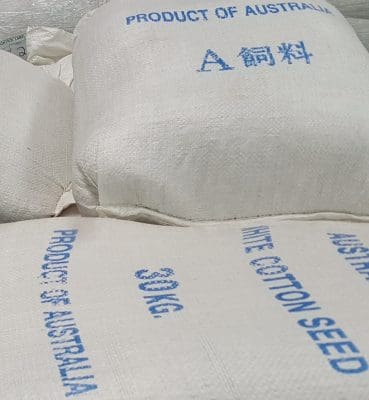DIMINISHING yield prospects for dryland cotton crops and a flurry of new-crop export sales to China have caused cottonseed prices to skyrocket, stalling buying from lotfeeders looking to fill their ration requirements.
While a jump in Gwydir Valley ex gin cottonseed prices to $390/t — from mid 2016 levels $320/t and under — has prompted lotfeeders to close their order books, industry sources say the grainfed beef sector is likely to return to the market once gin output gives a clearer picture of new-crop supply.
Already this year, China’s stockfeed sector — mainly dairy — has bought between 300,000t and 400,000t of cottonseed for export, Woodside Commodities director Hamish Steele-Park said.
But after that strong start, fresh export sales had lost momentum recently.
“Crop yield prospects have diminished  due to hot weather, affecting mainly dryland,” he said. “The cotton crop was estimated at 4.5 million bales, but could be as low at 4 million bales now. That’s limiting anticipated availability of cottonseed.”
due to hot weather, affecting mainly dryland,” he said. “The cotton crop was estimated at 4.5 million bales, but could be as low at 4 million bales now. That’s limiting anticipated availability of cottonseed.”
Industry sources told Grain Central new-crop cottonseed export business traded actively from September last year. The peak delivery period will be May, June and July 2017 for major container ports Melbourne, Sydney and Brisbane.
Cotton crop yield cut
Cotton ginning is under way in Central Queensland and with heat affecting dryland crops in southern Queensland also, big volumes are not likely to be available until gins on the Queensland-NSW border start up for the season next month.
Other cottonseed markets
North Asia’s demand for Australian cottonseed was begun decades ago by beef cattle feeders in Japan.
Great feeding performance and visual appeal deliver premiums for Australian cottonseed sold into Japan.
Australia’s clean, green image, and competitive pricing have also forged a developing cottonseed market in China’s industrial-scale dairy herds.
This is because Chinese customers find value in Australian cottonseed as feed for cattle. The stockfeed market into China is becoming more significant than the cottonseed oil extraction market, among the mainstream oilseeds such as soybeans and canola.
Cottonseed has considerable value in feedlot rations

Rob Lawrence
“There is value in cottonseed as a source of energy and effective fibre,” Australian feedlot nutritionist Rob Lawrence from Integrated Animal Production said.
“A percentage of cottonseed in the cattle diet can stimulate the rumen and help maintain digestive health.”
“Nnutritionists often talk about ration formulation in terms of dollars per energy unit, and in those terms, effective fibre is a relatively expensive nutrient per energy unit,” Dr Lawrence said.
Cottonseed is seen as an exceptional feed input and has no easy substitute in the ruminant ration.
Australian feedlots normally secure sufficient cottonseed from the previous year’s crop to meet requirements into the Easter period, when supplies transition to new crop. The level of cover was reportedly adequate this year, though unusually low beef margins curtailed cottonseed monthly requirement for some feedlots. It resulted in some late parcels of contracted cottonseed being sold back into the stronger spot market.
Because cottonseed has a fuzzy surface, it does not flow, and is low density. It is therefore generally held in flat storage, such as a bulk shed, which needs to be cleared and cleaned for at least several weeks at the end of each season to assist with life-cycle control of stored-grain insect pests.
This dynamic punctuates the need for careful stock control and contract logistics management.



HAVE YOUR SAY